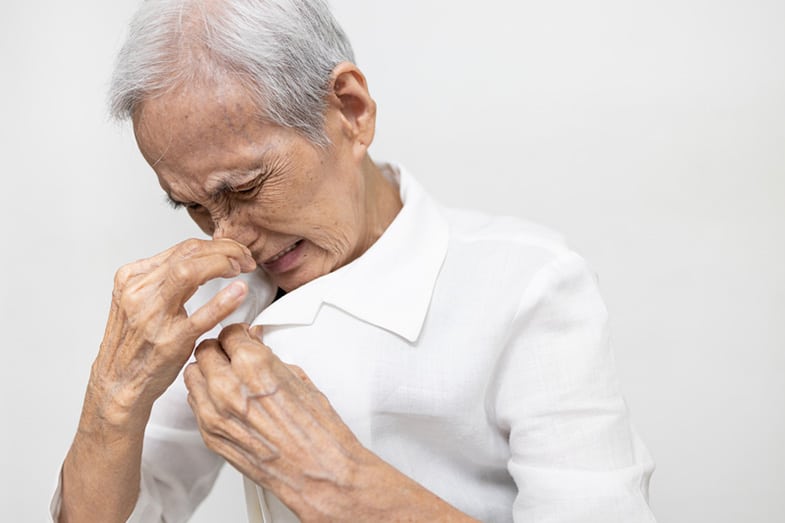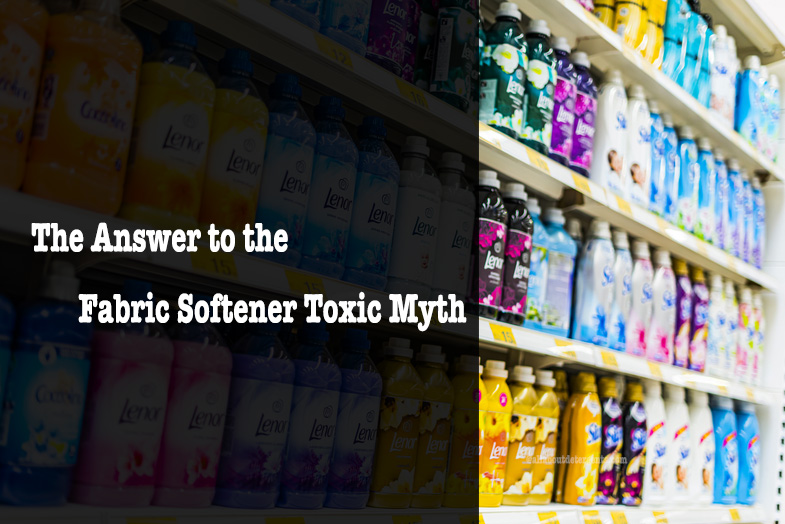Fabric softeners are the most toxic of all laundry products. It is not a myth; it is a fact that can be proven by the number of toxic chemicals it contains. Fortunately, people are becoming increasingly aware of the poisonous ingredients in laundry detergent, which is one reason we see a decline in the sale of fabric softeners.
It was a typical day for me in my office when I felt the absence of one of my colleagues. It was not new for me as that person took off several times a month. It was ironic to me how I never bothered asking her about her situation. On enquiring, I discovered she was suffering from a severe rash all over her body. Shockingly, the inflammation could take her to the emergency room that day.
It was all because of the fabric softener and its toxic ingredients. Later that day, I threw the fabric softener out of the window and replaced it with a better product that was not hazardous. Want to know what it is? Read to the end.
Are Fabric Softeners Toxic?
Fabric softener is a combination of chemicals that coats the outer surface of our clothes to make them appear soft and cling-free. This product gained popularity in the mid-twentieth century. Due to the many harmful chemicals in the detergent, clothes become rigid and lose their freshness. This was when fabric softeners proved to be beneficial.
However, due to the advancement in almost every field, we now have laundry detergents that soften and clean clothes. The presence of bleach and softening agents in laundry detergents has nearly denied the purpose of using fabric softener and chlorine bleach separately.
Can Fabric Softeners Be Useless?
In addition to being toxic, fabric softeners can prove useless in many cases. If you carefully read the labels and tags of most sports clothes, you will notice that they recommend not using fabric softener. Why, they say, this is a question whose answer lies in the way fabric softener works.
When you add the fabric softener to the washing in the rinse cycle, the fabric softener covers the outer layer of clothes with a thick coating. This chemical coating is what makes the clothes appear soft.
Sports clothes and fabrics are made to absorb moisture so they can be wicked to the fabric’s outer surface from where it evaporates. When these athletic clothes are washed in fabric softeners, the thick coating of chemicals prevents the moisture from evaporating and keeps it trapped inside.
As a result, the stains and moisture get confined in the fabric, and thus, it becomes difficult to remove them. Even after washing it several times, you can smell the foul odor of sweat. The sole reason for this odor is fabric softener.
Are Fabric Softeners Safe?

By now, you must have understood the workings of fabric softeners. Fabric softeners coat the clothes with chemicals that make them appear soft. The layer of chemicals on the outer surface makes the clothes more explosive, as research has proved.
In addition, we all know the number of toxic ingredients in fabric softeners. The chemicals are not always mentioned, so we never know what fragrances are added. Compounds like quats, chloroform, preservatives, and fragrances are always used in fabric softeners. These chemicals devastate our lives and are in no way safe for us.
Here is a list of some toxic chemicals that are a part of fabric softeners.
- Limonene – Carcinogenic
- Quats – Causes skin irritation
- Ethyl alcohol – affects the nervous system
- Linalool – affects the heart and nervous system
- Chloroform – carcinogenic
- Benzyl alcohol – affects the respiratory system
- Hydrochloric acid – damages the skin and causes burns.
Read More: Are Fabric Softeners Good for Asthma?
Toxic Chemicals in Fabric Softeners
No laundry product is free of toxic chemicals. To make the products more appealing to customers, companies have started using synthetic chemicals harmful to the environment and human health. With the label of softness and freshness, these fabric softeners are causing skin rash and several respiratory disorders. Let us look at these chemicals to understand how they affect our health.
Chloroform
Chloroform is an organic compound that is present in commercial fabric softeners, where it acts as an aromatic agent and as a solvent. It has significant effects on the respiratory system of humans, where it causes breathing problems, nose and throat irritation, and shortness of breath. Following this, a person feels nauseous, drowsiness, and dizzy.
Other than that, chloroform can also affect the central nervous system of a human. Chloroform is also known to interfere with the liver’s normal functioning; as a result, it can lead to jaundice and hepatitis. A high concentration of chloroform can make a person unconscious.
This shows that we can get soft and static-free clothes using fabric softeners but at the cost of our health.
Hydrochloric Acid
Just like chloroform, hydrochloric acid also affects the upper respiratory tract of humans when inhaled. It is one of those essential ingredients that are used in fabric softeners. When inhaled in high concentration, it can cause injury to our mouth and stomach.
In laboratories, this chemical is used very carefully. When it comes to direct contact with our eyes, it can potentially cause irreversible and life-threatening damage. This chemical is used in fabric softeners, though in a minimal concentration. You can imagine what it can do to your skin as the clothes stay in touch with your body for a long time.
Fragrances
To make the products more appealing to the end-users, fragrances are added. Its use has increased to a great extent over the past few decades. Almost every household product contains synthetic fragrances.
Galaxolide and Phthalates are the familiar synthetic fragrances used in fabric softeners. Different types of odors in the product get along and bring disastrous results. Skin irritation, dermatitis, and allergies are widespread problems.
People allergic to scents and those with asthma should altogether avoid fabric softeners. These chemicals can trigger your allergies in the worst way. 1,4-dioxane and acetaldehyde are carcinogens; still, they are used as fragrances in fabric softeners.
You can find fragrance-free, safe fabric softeners in the market as well. They are far better and have a lower risk of causing respiratory disorders than softeners containing fragrances.
Preservatives and Dyes
Some chemicals are added with preservatives to keep the fabric softener last longer.
So many preservatives like formaldehyde, BHA, BHT, and Benzoates are likely to cause hyperactivity, asthma, allergy, and cancer.
Methylisothiazolinone is a ubiquitous yet dangerous chemical used in fabric softeners as a preservative. It is recognized as an allergen and is known to cause several respiratory disorders and skin irritation. Long-term exposure to these preservatives can affect the heart tissues, which is life-threatening to older people.
Glutaral is yet another preservative that, besides being harmful to humans, is also toxic to aquatic life. It is a skin irritant and an asthmagen.
Other than that, another typical chemical called DMDM Hydantoin is added to fabric softeners. This not only affects the internal organs but also harms the external organs. Like other chemicals, it is also a skin irritant and an allergen.
Fabric softener coats the outer surface of clothes with chemicals. When we wear these clothes, our bodies come into contact with those chemicals directly. The longer our body stays in touch with the toxic chemicals, the more harmful effects they will cause.
Quats
The chemicals responsible for bringing the softening effect to the clothes are known as Quats, which is short for Quaternary Ammonium Compounds. Dialkyl dimethyl ammonium methyl sulfate, diethyl ester dimethyl ammonium chloride, and distearyldimonium chloride are common quats in fabric softeners.
Quats have a very close link to respiratory disorders. These chemicals are the most common cause of asthma. They are so dangerous that quats are also termed asthmagens.
In addition to causing several respiratory disorders, quats also have bacterial-killing properties. This is utterly useless as we already get rid of bacteria and other germs using a laundry detergent. The use of quats in fabric softeners causes the development of antibiotic-resistant microorganisms.
If you already have asthma, using quats-containing products can trigger your condition and make it even worse. Quats can bring disastrous health results in children. Since children have an undeveloped immune system, these toxic chemicals will likely affect their lives in the worst way possible.
Read More: Are Fabric Softeners Necessary?
Alternative to Fabric Softeners

So many natural, cheaper, and chemical-free options are available for softening the clothes. However, dryer sheets are excluded from the list since they are equally toxic. They work in almost the same way and coat the clothes with chemicals. Let us avoid them and have a look at more natural options.
Water Softener
Hard water is an issue for a lot of people. It has so many disadvantages. You will notice the roughness in your clothes after washing them in hard water. Hard water makes the clothes stiff, causes their color to fade, and makes them rough, which is uncomfortable to wear.
Mixing a water softener into your home’s water supply is beneficial. It helps you by removing all the minerals from the water, thus making it soft enough to wash the clothes quickly. When the water is weak, it will not form a chemical film on the clothes. Instead, the detergent will be rapidly absorbed into the clothes, and it will also be easier to rinse the detergent.
Using a water softener reduces the need for fabric softener, keeping yourself and your family away from toxic chemicals.

Baking Soda
Baking soda is a natural water softener. It is added to the water right after adding it to the washing machine. Baking soda lowers the pH of the water and makes it soft. Soft water makes it easier to absorb the detergent in the clothes and rinse the detergent well, thus lowering the need for fabric softener.
Vinegar
It is the best natural fabric softener that has no side effects. Add just a cup of vinegar to the washing machine during the rinse cycle. This makes the clothes softer and does not have any smell. This natural softener is best for people who are allergic to scents.
Dryer Balls

It is another natural way to soften the clothes. Dryer balls are a great alternative to dryer sheets and fabric softeners. Dryer balls are round woolen balls added to the dryer and the clothes. These balls make the dresses soft, remove wrinkles, and appear fresh.
Dryer balls contain no chemicals and are made with 100% wool. Using these saves energy and prevents your pockets from emptying on fabric softener. You save energy because clothes get dried quicker and take less time to get ironed.
In Conclusion
Fabric softeners are made entirely of really toxic chemicals. The major compounds that are QUATS are skin irritants. In addition, all the dyes, preservatives, and fragrances in the fabric softener negatively affect our health.
Fabric softener is damaging our environment with the harsh chemicals present in it. Most of the ingredients in it are fatal for aquatic animals. In addition, the daily cost of fabric softener is high.
You can pick many better alternatives to soften your clothes and reduce the number of wrinkles, thus saving money and energy simultaneously. Try those and let us know your experience in the comments below.

